| |
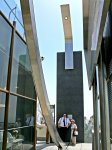 |
Los Angeles |
California |
USA |
Sun Alignment |
Dial 593 |
| A bronze-faced meridian arc dial 18 feet long, 13.5 feet high and 7 inch wide. Displays the meridian line and is inscribed with month and day markings, seasonal and lunar indicators and constellation figures. An overhead lens projects a solar image on the inscriptions. A large adjacent symbol is positioned to indicate which set of date markings is to be read from the meridian line. In a modern twist, photoelectric sensors embedded in the face of the arc are activated by the transiting spot of sunlight and send a signal to illuminate LED indicators on the 22 foot wide stainless steel ecliptic chart overhead, lighting up the stars of the constellation through which the sun is passing. |
| |
| |
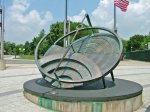 |
Queens |
New York |
USA |
Sculpture/Artwork |
Dial 592 |
| A 6 foot diameter bronze sculpture reclined 50° (latitude is 40° 45' N) with slit gnomon and hour marks. Gift of Joan and Richard Scheuer in 2000. More sculpture than sundial, it does have some hour marks but reclines and appears to be out-of-plane. |
| |
| |
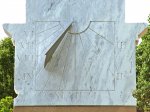 |
Princeton |
New Jersey |
USA |
Vertical Dial |
Dial 591 |
| White marble 5x5 foot vertical dial declines 23° E with metal gnomon. Sits atop 12 foot cement pillar. Hour lines with Roman numerals are shown for every hour from 6 AM to 3 PM. North side of dial face depicts a tiger; donators Lee & Margaret Butler are named below with date 1983. |
| |
| |
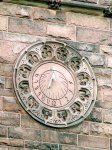 |
Princeton |
New Jersey |
USA |
Vertical Dial |
Dial 590 |
| Circular vertical dial about 10 foot diameter on stone wall with bronze gnomon and substyle. Dial declines 23° east of south. Hour lines every half hour. Arabic hour numerals with 12 Zodiacal signs. |
| |
| |
 |
Wheaton |
Illinois |
USA |
Horizontal Dial |
Dial 589 |
| Horizontal dial with 20 foot stainless steel gnomon. On the ground (dial face) are hour lines, analemma, date, and time before sunset. Built to commemorate DuPage County residents killed in military conflicts. |
| |
| |
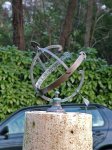 |
Washington |
District of Columbia |
USA |
Armillary Sphere |
Dial 588 |
| A 20 inch diameter bronze armillary on a four foot pedestal. Roman hour numerals from 3 AM to 9 PM. |
| |
| |
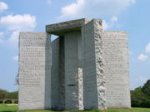 |
Elberton |
Georgia |
USA |
Sun Alignment |
Dial 587 |
| A calendrical dial consisting of six granite slabs and standing 19 feet high arranged as a center stone with four surrounding stones and a capstone. A channel through stone indicates the celestial pole and a horizontal slot indicates the annual travel of the sun. The stone faces are engraved with ten guidelines or principles in eight different languages. |
| |
| |
 |
Terre Haute |
Indiana |
USA |
Sun Alignment |
Dial 586 |
| Via Solaris, a 20x15x4 foot granite, stainless steel and bronze calendrical dial showing yearly equinoxes and summer solstice. |
| |
| |
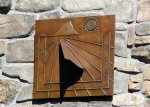 |
Prescott |
Arizona |
USA |
Vertical Dial |
Dial 585 |
| An 18x20 inch cast bronze vertical dial declining 22? west of south on the wall of a private home. Dial face includes a stylized sun and outline of Thumb Butte, a prominent local landmark. Dial can be viewed by first contacting the owner. |
| |
| |
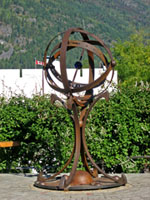 |
Nelson |
British Columbia |
Canada |
Armillary Sphere |
Dial 584 |
| This is a lovely dial in a lovely setting. The armillary of wrought iron is intricately and carefully done and blends with the surrounding garden that uses wrought iron railings made with the same look to continue the theme of the sundial. The dial is a 4 foot wide by 6 foot tall armillary of mild steel and blown glass with punched Roman numerals of the hours on the equatorial ring. The ecliptic ring includes zodiacal symbols. Dial base has a 12 inch hemispherical time capsule to be opened October 14, 2015. |
| |
| |
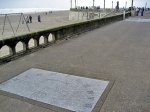 |
Seaside |
Oregon |
USA |
Analemmatic Dial |
Dial 583 |
| A granite analemmatic dial on the Promenade sidewalk near overlooking the beach. This dial, built in 1987, replaces an earlier dial painted on this sidewalk. Dial face is inscribed, "Enjoy your time in Seaside." While evoking the earlier painted dial, this new dial is not well designed and will have serious errors through the year. See the NASS Registry for a picture of the earlier painted dial. |
| |
| |
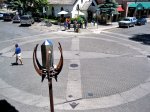 |
Ketchum |
Idaho |
USA |
Gnomonic or Projection Dial |
Dial 582 |
| This sundial was never finished. Update 8/10/2007 from Brad Needham: Thanks for the question about the Ketchum sundial. It's a puzzling work, and it took me quite a few Google searches to find a bit of the story: evidently a local (to the Ketchum area) sculptor submitted a sundial design to the city, and somehow the deal fell apart after the dial was made but before the sculptor finished the gnomon. So Ketchum is left with all the markers in the street intersection for the equinox, the noon summer and winter solstices, and an analemma (of some sort), but no gnomon to make it all work. |
| |
| |
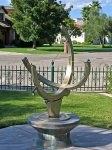 |
Las Vegas |
Nevada |
USA |
Equatorial Dial |
Dial 581 |
| An equatorial dial with partial armillary rings made of stainless steel and brass with chrome trim. Dial face has hour lines for solar and longitude-corrected time. Inscribed with zodiacal symbols and dates. |
| |
| |
 |
Parma |
Ohio |
USA |
Armillary Sphere |
Dial 580 |
| A three foot armillary sundial with equatorial ring and gnomon pointer on a stone base with dedication plaque. Dial was built by the local high school vocational welding class in 1988. |
| |
| |
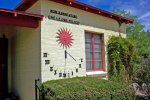 |
Tucson |
Arizona |
USA |
Vertical Dial |
Dial 579 |
| Located on a side street wall of a private home, this 4x6 foot due south vertical dial uses welded iron numerals and gnomon. Built in 1954, this is the oldest known sundial in Tucson. Designed using Mayall and Mayall's "Sundials" and described in detail in April, 1954 Home and Garden Magazine. |
| |
| |
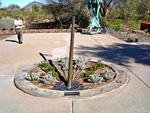 |
Phoenix |
Arizona |
USA |
Horizontal Dial |
Dial 578 |
| A 10 foot diameter horizontal dial with steel gnomon. Live desert plants fill planters delineated by hour lines. |
| |
| |
 |
Seattle |
Washington |
USA |
Gnomonic or Projection Dial |
Dial 577 |
| A colored-aperture projection calendrical sundial with one functional and four decorative 18 inch round clear stained glass apertures. Markings on floor indicate positions of projected orange light spot at solar noon from the spring to fall equinox. An additional noon mark indicates opening date of library. |
| |
| |
 |
Glenwood Springs |
Colorado |
USA |
Analemmatic Dial |
Dial 576 |
| An 11x15 foot poured concrete human analemmatic dial with Standard and DST numerals, seasonal markers and an EOT plaque. The dial is located on the playground of an elementary school. |
| |
| |
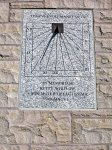 |
Victoria |
British Columbia |
Canada |
Vertical Dial |
Dial 575 |
| A 30x20-inch vertical dial declining 7° 33' west of south made of granite inset in a stone wall. A memorial dial for Betty Whitlow commissioned by Dean Brian Whitlow. Inscribed, "IN MEMORIAM BETTY WHITLOW, UXOR MATER DELICTISIMUA, MCMXCVI." Information on EOT and longitude corrections are available just inside the south door of the cathedral. |
| |
| |
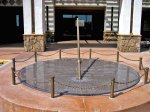 |
Surprise |
Arizona |
USA |
Horizontal Dial |
Dial 574 |
| A 108-inch diameter granite dial face with a 92-inch steel gnomon and nodus. Dial furniture includes a solar noon mark, sunrise and sunset points on the solstices and equinoxes, ecliptic date lines and an EOT graph. |
| |
| |
 |
Miami |
Florida |
USA |
Analemmatic Dial |
Dial 573 |
| A 16 foot diameter analemmatic dial of broken mosaic tiles. The numerals, months and lines are made with broken colored tiles. The major axis is 10 feet. A movable vertical gnomon is available for increased reading accuracy but a standing child is the usual gnomon. The colored number tiles are white for DST and black for ST. |
| |
| |
 |
Victoria |
British Columbia |
Canada |
Horizontal Dial |
Dial 572 |
| A replica 12-inch bronze horizontal dial on a concrete plinth. This dial is a memorial for Marjorie Napier, a twelve-year-old St. Ann's student who died on 31 May, 1922. The original dial and limestone plinth were moved to Queenswood, a private retirement home for elderly nuns and seniors. A plaque for the replica dial reads, "In memory of Una Holm (Robertson) Class of 1928. Thank you the Sisters of St Ann's, the strength of Sister Eleanor Marie and the Rock which was St Ann's Academy. Replica sundial donated by husband Sandy E S A Holm and their daughter Karen Michaelson (Holm) Class of '53." |
| |
| |
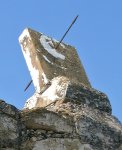 |
San Ygnacio |
Texas |
USA |
Equatorial Dial |
Dial 571 |
| A stone equatorial dial with an iron gnomon. Inscribed on both sides with hour lines. Placed above an entrance to a walled fort also built in 1851. Legend says Jose Villarreal designed and built the dial to celebrate his escape in 1820 as a child after capture by Lipan Apache Indians and being guided by the north star in his return home. Dial Recorder Mary Garza is the great-great-granddaughter of Jose Villarreal. |
| |
| |
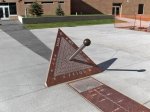 |
Colorado Springs |
Colorado |
USA |
Equatorial Dial |
Dial 570 |
| A 4 inch thick rose granite equatorial dial with a triangular dial face 60 inches on a side. A 70 inch long gnomon rod holds a 6 inch diameter spherical bronze nodus showing Earth as seen from space placed so that the Earth's axis is on the gnomon axis. The dial face shows solar noon and the dateline shows the date at solar noon and the equation of time. The granite plates are set 4 inches into concrete. |
| |
| |
 |
South Woodstock |
Vermont |
USA |
Vertical Dial |
Dial 569 |
| A painted 47x72 inch vertical dial of red oak declining east. Markings include analemmas for each hour, solstice declination lines and day lines for the first of each month with Zodiac icons on perimeter. Contact dial designer David Scott to arrange viewing. |
| |
| |
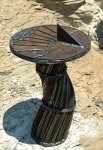 |
Gallup |
New Mexico |
USA |
Horizontal Dial |
Dial 568 |
| An 18 inch diameter horizontal dial of welded steel with a naturally weathered rusty brown finish. The hour lines are corrected for longitude and summer and winter solstice lines are shown. |
| |
| |
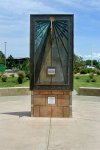 |
Albuquerque |
New Mexico |
USA |
Vertical Dial |
Dial 567 |
| A vertical "Icarus Sundial" of bronze, copper and ceramic 86 inch high x 48 inch wide on a 30 inch high pedestal in front of the Explora science museum. The gnomon depicts Icarus falling; the back side depicts Icarus ascending toward the sun. The pedestal is placed within a 20 foot concrete circle showing a labyrinth defined by a sandblasted path of feathers. |
| |
| |
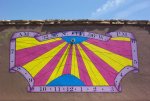 |
Tucson |
Arizona |
USA |
Vertical Dial |
Dial 566 |
| A vertical 44x92 inch dial declining 4.53? east of south painted on the rough textured stucco wall of a private home. The 2x4 inch tall conical horizontal gnomon is gold plated brass. The dial face is hand painted with elastomeric acrylic exterior house paint. The horizontal conical gnomon optimizes the nodus shadow at the location low latitude to show time and date. Dial face shows date/declination lines, solar noon mark and hour, 1/2-hour and 15 minute lines. To arrange viewing, contact owner Christina McVie. |
| |
| |
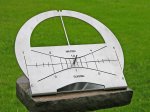 |
Flemington |
New Jersey |
USA |
Compound Dial |
Dial 565 |
| A 12x9-inch combination equatorial and polar dial made of stainless steel and titanium. Solstice and equinox lines are shown on the polar dial face. This sundial is located in the park behind the old county courthouse where the Lindburgh baby kidnapping trail was held. |
| |
| |
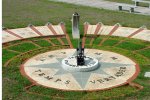 |
Habana |
La Habana |
Cuba |
Horizontal Dial |
Dial 564 |
| A monumental horizontal dial with rod gnomon and central cannon. First documented sundial in Cuba. |
| |
| |
 |
New York |
New York |
USA |
Vertical Dial |
Dial 563 |
| A large vertical dial declining east approximately 45? and displaying fanciful furniture. Hour lines are present but are difficult to see; hour numerals are not shown. Summer and winter solstice lines are shown with the winter solstice line near the gnomon foot because of the declination. The curved line shown for the equinox should be straight.
Six individual "Cultural Arcs" are positioned at specific time points on the dial face and are accompanied by upstanding dial furniture. Each "Cultural Arc" references distinct and in some cases overlapping cultural traditions and is made from 1/2" sheet aluminum, with a permanent (powder coated) color finish. Each "Cultural Arc" contains symbolic and aesthetic elements reflecting the ebb and flow of migration in the local East Harlem population. |
| |
| |
 |
Lake Wales |
Florida |
USA |
Analemmatic Dial |
Dial 562 |
| A large stone analemmatic in the Endangered Plant Garden. |
| |
| |
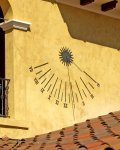 |
Little Rock |
Arkansas |
USA |
Vertical Dial |
Dial 561 |
| A 36-inch radius antiqued brass vertical dial declining 16.3° east of south mounted on exterior wall of private home. A separate bronze plaque shows EOT, dial coordinates and motto. Viewing of dial can be arranged by calling the owner. |
| |
| |
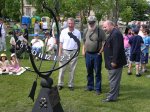 |
Humboldt |
Saskatchewan |
Canada |
Armillary Sphere |
Dial 560 |
| An equatorial armillary. |
| |
| |
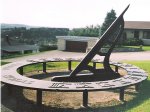 |
Grand Falls - Grand-Sault |
New Brunswick |
Canada |
Horizontal Dial |
Dial 559 |
| A horizontal dial using a 12 foot diameter blackened steel ring dial face and 8 foot high blackened steel gnomon. Dial face uses Roman numerals with XII at north. |
| |
| |
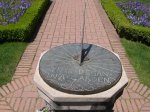 |
Woodside |
California |
USA |
Horizontal Dial |
Dial 558 |
| A 15 inch diameter well-patinaed horizontal bronze dial on a stone pillar. This dial was designed for a different location. The hour lines are cut for 50? N; the gnomon angle is 46.5? and is miss-located on the dial face. |
| |
| |
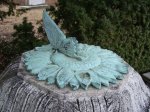 |
Cambridge |
Massachusetts |
USA |
Horizontal Dial |
Dial 557 |
| A well-patinaed horizontal bronze dial on a stone pillar. |
| |
| |
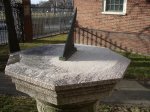 |
Cambridge |
Massachusetts |
USA |
Horizontal Dial |
Dial 556 |
| A stone horizontal dial on a pedestal about 4 ft. high donated to Harvard by class of 1870. |
| |
| |
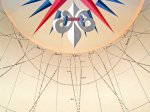 |
Englewood |
Colorado |
USA |
Gnomonic or Projection Dial |
Dial 555 |
| An internal cylindrical dial on the walls of the entrance tower to the Science Building of Kent Denver School. A glass-covered 1/8 inch aperture in the center of ceiling dome projects a spot light onto the inner vertical cylindrical wall of the vestibule. Aluminum strips mark the solar altitude and azimuth. Bronze strips mark the equinox and summer solstice. Bronze and nickel domed nails form the hour analemmas showing Mountain Standard Time with daylight savings time below. The dial design is by science teacher David Potter and architect Paul Hutton proportioned the "Sun Tower" so the summer solstice noon mark would be at the bottom of the cylindrical wall. Artwork on the ceiling includes a hand-painted winking "Sol" in a 24 point compass rose. |
| |
| |
 |
St. Louis |
Missouri |
USA |
Vertical Dial |
Dial 553 |
| A vertical dial of limestone and copper held in the hands of an angle statue. |
| |
| |
 |
Jemez Springs |
New Mexico |
USA |
Analemmatic Dial |
Dial 552 |
| Analemmatic dial of cast concrete 6m E-W by 2.2m N-S |
| |
| |
 |
Seaside |
Florida |
USA |
Horizontal Dial |
Dial 551 |
| A large horizontal dial with a steel gnomon much larger than the dial itself, yet aesthetically pleasing. The dial itself is an oval approximate 3 by 4 feet (1m by 1.1m) of concrete with bronze hour lines and numbers from 6am to 7pm. The dial and gnomon are surrounded by gravel, set in the center of a plaza contained by a 30 foot (10m) diameter hedge. |
| |
| |
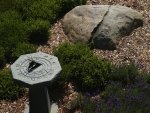 |
Sheboygan Falls |
Wisconsin |
USA |
Horizontal Dial |
Dial 550 |
| A 20 inch octagonal dial of bluestone on a 28 inch high base. The gnomon matches the latitude angle and the hour lines are approximate for a generalized geographic area. |
| |
| |
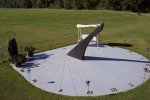 |
Claremore |
Oklahoma |
USA |
Horizontal Dial |
Dial 549 |
| A 24x36 foot all-concrete horizontal dial with marks to indicate summer solstice and equinox. Located on private property; contact owner Dan Wilson to arrange viewing. |
| |
| |
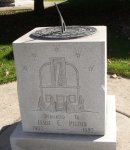 |
Delphos |
Ohio |
USA |
Horizontal Dial |
Dial 548 |
| A horizontal dial on a stone block. Dedicated to Leslie C. Peltier, recognized as "World's greatest non-professional astronomer" by Harvard Observatory. Dial sits atop a stone block, possibly marble. |
| |
| |
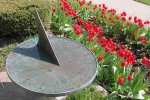 |
Elburn |
Illinois |
USA |
Horizontal Dial |
Dial 547 |
| A 30-inch diameter cast bronze dial with natural patina after more than 30 years exposure. Replaces a "garden" dial donated by Class of 1967 but destroyed by vandals. Dial is located on campus of private school but available for viewing during daylight hours. |
| |
| |
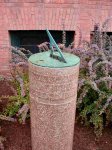 |
Norwich |
Connecticut |
USA |
Horizontal Dial |
Dial 546 |
| A well-patinaed horizontal dial placed atop a stone column. Dial sits atop a cast aggregate column. |
| |
| |
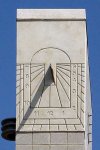 |
Lampeter |
Pennsylvania |
USA |
Vertical Dial |
Dial 545 |
| A 32x64-inch cast stone vertical declining dial located 25 feet up a vertical column at the school's entrance. An EOT plaque is located below the dial. |
| |
| |
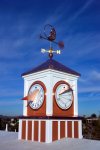 |
Tucson |
Arizona |
USA |
Vertical Dial |
Dial 544 |
| Four vertical dials on the faces of a 100-inch tall redwood cupola on the roof of a private residence. The 21-inch dial faces are kiln-fired porcelain on steel; the bezels and gnomons are copper. The dials are longitude corrected for MST. Three dials have solar noon marks. |
| |
| |
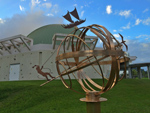 |
Kaneohe |
Hawaii |
USA |
Armillary Sphere |
Dial 543 |
| A 32-inch diameter bronze armillary dial with extensive Polynesian-themed motif. An integral plaque provides corrections for EOT and longitude within HST. The armillary includes ten bronze rings: horizon; solstitial colure (meridian); equinoctial (equator); Tropic of Cancer; Tropic of Capricorn; Arctic circle; Antarctic circle; "prime vertical circle" perpendicular to the meridian circle and horizon that spans from east to zenith to west; equinoctial colure perpendicular to meridian circle and equator passing through the north and south poles; and an "upright ring" inscribed with Zodiacal signs between the prime vertical and equator. |
| |